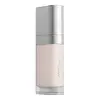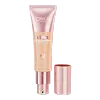What's inside
What's inside
 Key Ingredients
Key Ingredients

 Benefits
Benefits

 Concerns
Concerns

 Ingredients Side-by-side
Ingredients Side-by-side

Water
Skin ConditioningDimethicone
EmollientIsohexadecane
EmollientIsononyl Isononanoate
EmollientCaprylyl Dimethicone Ethoxy Glucoside
EmulsifyingZinc Stearate
Cosmetic ColorantDimethicone Crosspolymer
Emulsion StabilisingSorbitan Isostearate
EmulsifyingSqualane
EmollientGlycerin
HumectantButylene Glycol
HumectantAluminum/Magnesium Hydroxide Stearate
Emulsion StabilisingPhenoxyethanol
PreservativeSodium Chloride
MaskingNiacinamide
SmoothingPotassium Sorbate
PreservativeSodium Dehydroacetate
PreservativeCaprylic/Capric Triglyceride
MaskingTocopheryl Acetate
AntioxidantEthylhexyl Palmitate
EmollientRubus Idaeus Leaf Extract
Skin ConditioningDaucus Carota Sativa Extract
PerfumingHedychium Coronarium Root Extract
MaskingTrihydroxystearin
Skin ConditioningTheobroma Cacao Seed Extract
AntioxidantCitric Acid
BufferingSodium Hyaluronate
HumectantMica
Cosmetic ColorantCI 77891
Cosmetic ColorantIron Oxides
Water, Dimethicone, Isohexadecane, Isononyl Isononanoate, Caprylyl Dimethicone Ethoxy Glucoside, Zinc Stearate, Dimethicone Crosspolymer, Sorbitan Isostearate, Squalane, Glycerin, Butylene Glycol, Aluminum/Magnesium Hydroxide Stearate, Phenoxyethanol, Sodium Chloride, Niacinamide, Potassium Sorbate, Sodium Dehydroacetate, Caprylic/Capric Triglyceride, Tocopheryl Acetate, Ethylhexyl Palmitate, Rubus Idaeus Leaf Extract, Daucus Carota Sativa Extract, Hedychium Coronarium Root Extract, Trihydroxystearin, Theobroma Cacao Seed Extract, Citric Acid, Sodium Hyaluronate, Mica, CI 77891, Iron Oxides
Water
Skin ConditioningIsododecane
EmollientCoco-Caprylate/Caprate
EmollientDicaprylyl Carbonate
EmollientGlycerin
HumectantPEG-30 Dipolyhydroxystearate
EmulsifyingZea Mays Starch
AbsorbentButylene Glycol
HumectantNiacinamide
SmoothingAscorbyl Glucoside
AntioxidantPentylene Glycol
Skin ConditioningPhenoxyethanol
PreservativeMagnesium Sulfate
Caprylyl Glycol
EmollientSorbitol
HumectantDisteardimonium Hectorite
StabilisingSynthetic Fluorphlogopite
Tocopherol
AntioxidantSilica Silylate
EmollientSodium Stearate
CleansingCetearyl Alcohol
EmollientPropylene Carbonate
SolventSodium Hydroxide
BufferingDisodium Stearoyl Glutamate
CleansingCeteareth-20
CleansingCalcium Chloride
AstringentAluminum Hydroxide
EmollientMica
Cosmetic ColorantCI 77491
Cosmetic ColorantCI 77492
Cosmetic ColorantCI 77499
Cosmetic ColorantCI 77891
Cosmetic ColorantWater, Isododecane, Coco-Caprylate/Caprate, Dicaprylyl Carbonate, Glycerin, PEG-30 Dipolyhydroxystearate, Zea Mays Starch, Butylene Glycol, Niacinamide, Ascorbyl Glucoside, Pentylene Glycol, Phenoxyethanol, Magnesium Sulfate, Caprylyl Glycol, Sorbitol, Disteardimonium Hectorite, Synthetic Fluorphlogopite, Tocopherol, Silica Silylate, Sodium Stearate, Cetearyl Alcohol, Propylene Carbonate, Sodium Hydroxide, Disodium Stearoyl Glutamate, Ceteareth-20, Calcium Chloride, Aluminum Hydroxide, Mica, CI 77491, CI 77492, CI 77499, CI 77891
 Reviews
Reviews

Ingredients Explained
These ingredients are found in both products.
Ingredients higher up in an ingredient list are typically present in a larger amount.
Butylene Glycol (or BG) is used within cosmetic products for a few different reasons:
Overall, Butylene Glycol is a safe and well-rounded ingredient that works well with other ingredients.
Though this ingredient works well with most skin types, some people with sensitive skin may experience a reaction such as allergic rashes, closed comedones, or itchiness.
Learn more about Butylene GlycolCi 77891 is a white pigment from Titanium dioxide. It is naturally found in minerals such as rutile and ilmenite.
It's main function is to add a white color to cosmetics. It can also be mixed with other colors to create different shades.
Ci 77891 is commonly found in sunscreens due to its ability to block UV rays.
Learn more about CI 77891Glycerin is already naturally found in your skin. It helps moisturize and protect your skin.
A study from 2016 found glycerin to be more effective as a humectant than AHAs and hyaluronic acid.
As a humectant, it helps the skin stay hydrated by pulling moisture to your skin. The low molecular weight of glycerin allows it to pull moisture into the deeper layers of your skin.
Hydrated skin improves your skin barrier; Your skin barrier helps protect against irritants and bacteria.
Glycerin has also been found to have antimicrobial and antiviral properties. Due to these properties, glycerin is often used in wound and burn treatments.
In cosmetics, glycerin is usually derived from plants such as soybean or palm. However, it can also be sourced from animals, such as tallow or animal fat.
This ingredient is organic, colorless, odorless, and non-toxic.
Glycerin is the name for this ingredient in American English. British English uses Glycerol/Glycerine.
Learn more about GlycerinMica is a naturally occurring mineral used to add shimmer and color in cosmetics. It can also help improve the texture of a product or give it an opaque, white/silver color.
Serecite is the name for very fine but ragged grains of mica.
This ingredient is often coated with metal oxides like titanium dioxide. Trace amounts of heavy metals may be found in mica, but these metals are not harmful in our personal products.
Mica has been used since prehistoric times throughout the world. Ancient Egyptian, Indian, Greek, Roman, Aztec, and Chinese civilizations have used mica.
Learn more about MicaNiacinamide is a multitasking form of vitamin B3 that strengthens the skin barrier, reduces pores and dark spots, regulates oil, and improves signs of aging.
And the best part? It's gentle and well-tolerated by most skin types, including sensitive and reactive skin.
You might have heard of "niacin flush", or the reddening of skin that causes itchiness. Niacinamide has not been found to cause this.
In very rare cases, some individuals may not be able to tolerate niacinamide at all or experience an allergic reaction to it.
If you are experiencing flaking, irritation, and dryness with this ingredient, be sure to double check all your products as this ingredient can be found in all categories of skincare.
When incorporating niacinamide into your routine, look out for concentration amounts. Typically, 5% niacinamide provides benefits such as fading dark spots. However, if you have sensitive skin, it is better to begin with a smaller concentration.
When you apply niacinamide to your skin, your body converts it into nicotinamide adenine dinucleotide (NAD). NAD is an essential coenzyme that is already found in your cells as "fuel" and powers countless biological processes.
In your skin, NAD helps repair cell damage, produce new healthy cells, support collagen production, strengthen the skin barrier, and fight environmental stressors (like UV and pollution).
Our natural NAD levels start to decline with age, leading to slower skin repair, visible aging, and a weaker skin barrier. By providing your skin niacinamide, you're recharging your skin's NAD levels. This leads to stronger, healthier, and younger looking skin.
Another name for vitamin B3 is nicotinamide. This vitamin is water-soluble and our bodies don't store it. We obtain Vitamin B3 from either food or skincare. Meat, fish, wheat, yeast, and leafy greens contain vitamin B3.
The type of niacinamide used in skincare is synthetically created.
Learn more about NiacinamidePhenoxyethanol is a preservative that has germicide, antimicrobial, and aromatic properties. Studies show that phenoxyethanol can prevent microbial growth. By itself, it has a scent that is similar to that of a rose.
It's often used in formulations along with Caprylyl Glycol to preserve the shelf life of products.
Water. It's the most common cosmetic ingredient of all. You'll usually see it at the top of ingredient lists, meaning that it makes up the largest part of the product.
So why is it so popular? Water most often acts as a solvent - this means that it helps dissolve other ingredients into the formulation.
You'll also recognize water as that liquid we all need to stay alive. If you see this, drink a glass of water. Stay hydrated!
Learn more about Water